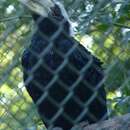en
names in breadcrumbs


The black hornbill (Anthracoceros malayanus) is a species of bird of the hornbill family Bucerotidae. It lives in Asia in Brunei Darussalam, Indonesia, Malaysia, Singapore, Thailand.
The Black-casqued Hornbill has a selectiveness towards the environment and resources when it comes to reproduction. This organism will only start breeding and nesting when there is a large supply of fruits available, and in trees of larger size. When there are limited resources available, and may curtail nesting for years when there is a low availability of fruits(4). It is the major seed disperser for Durio graveolens, a species of durian.[3] The connection is strong enough to reflect in some of the common names for the fruit: The Kenyah and Dayak peoples call it durian anggang (lit. 'hornbill durian'),[4] and in Malay it is called durian burong/durian burung[5] (lit. 'durian bird'),[4]
The male has a yellowish bill while the female has a dark grey bill.


{{cite journal}}: CS1 maint: DOI inactive as of December 2022 (link) The black hornbill (Anthracoceros malayanus) is a species of bird of the hornbill family Bucerotidae. It lives in Asia in Brunei Darussalam, Indonesia, Malaysia, Singapore, Thailand.
The Black-casqued Hornbill has a selectiveness towards the environment and resources when it comes to reproduction. This organism will only start breeding and nesting when there is a large supply of fruits available, and in trees of larger size. When there are limited resources available, and may curtail nesting for years when there is a low availability of fruits(4). It is the major seed disperser for Durio graveolens, a species of durian. The connection is strong enough to reflect in some of the common names for the fruit: The Kenyah and Dayak peoples call it durian anggang (lit. 'hornbill durian'), and in Malay it is called durian burong/durian burung (lit. 'durian bird'),